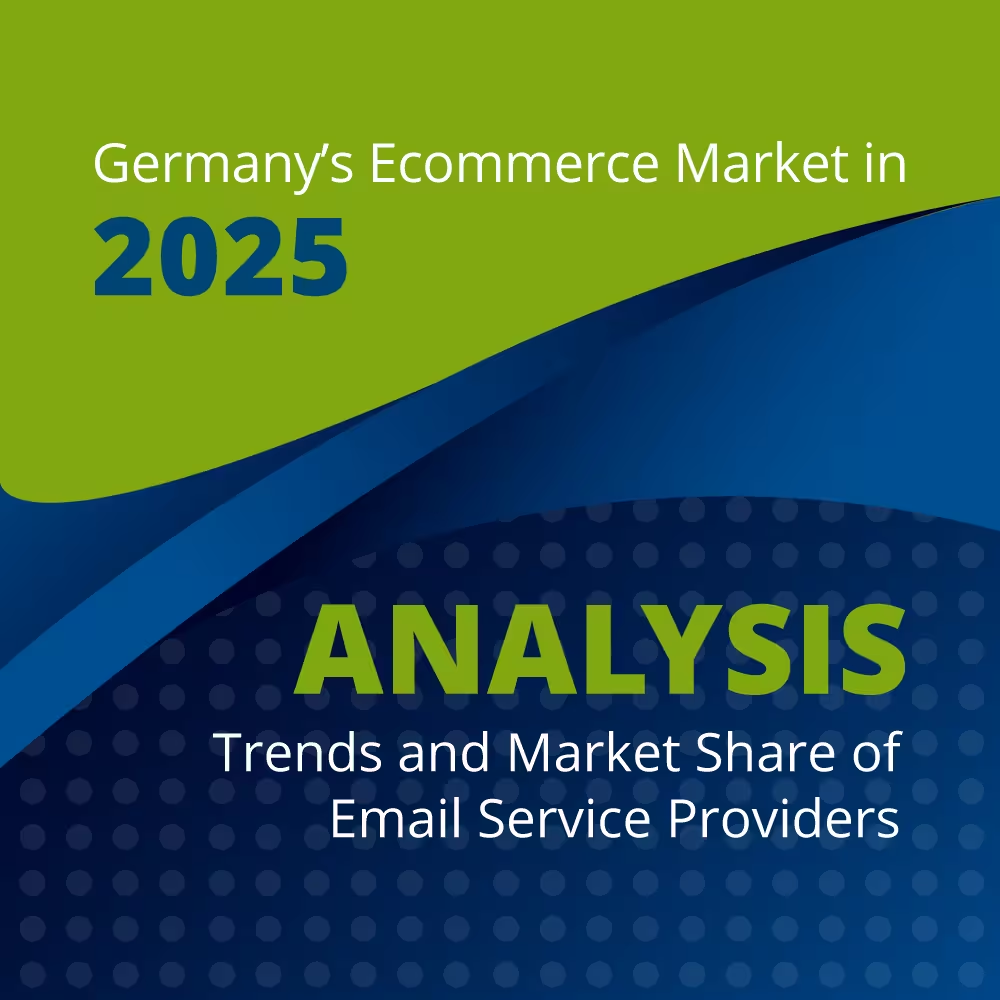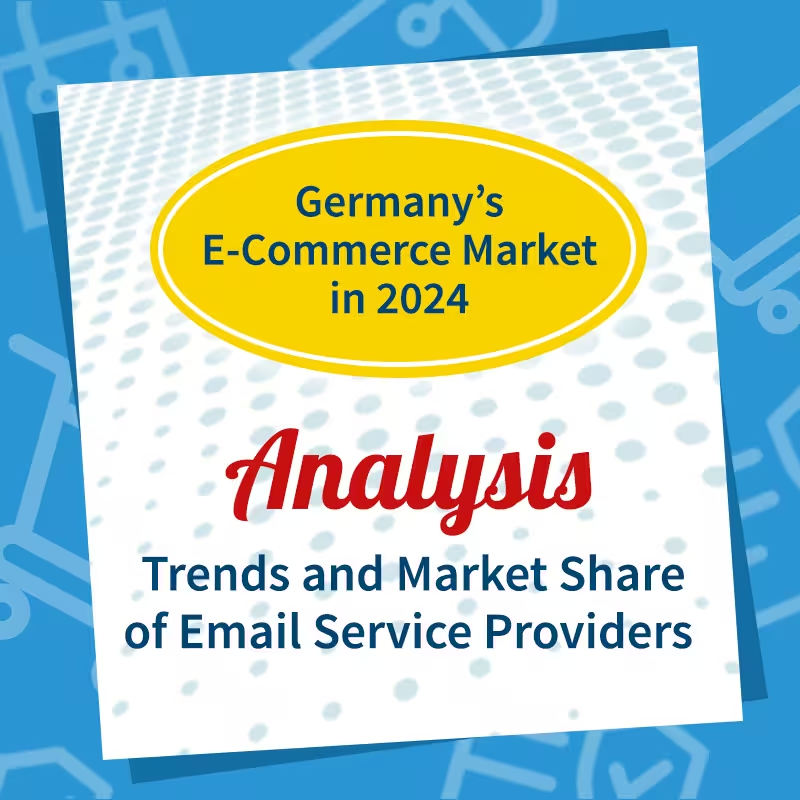German email boxes - a tornado in slow motion?
Isn't it nice when something doesn't change in the big, wide online world? In any case, that seems to be the case when it comes to email addresses: Every two to three years, we at Publicare evaluate several million addresses that were used by German consumers for online shopping — and every year the same (e-mail) mailbox providers top the list in more or less the same order (Here you can find the 2019 email study). Which social platforms and messenger services are used may be subject to fast-moving trends — but the free email or email address is not easily changed. This makes email marketers happy, who put a lot of work into maintaining their email mailing lists and optimizing the presentation of their newsletters with various providers and email clients.
However, there is a clear trend that we have been observing since 2014 and can confirm again in 2022. The email service market is being severely shaken up — but so slowly that you don't see the tornado until you compare the time series over the years.

Here you can find the latest analysis results for most popular email services in Germany 2024
80% of Germans rely on the top 5 email address providers
Germany's five largest email services continue to share around 80% of the market among themselves (2019:81.4%), with the two leading mailbox providers alone United Internet with its similarly strong brands GMX and Web.de as well as google account for 60.7% of the market (2019:58.6%). From 9th place, the market share falls to less than 1%, namely to 0.6% for Mail.ru-Group (in 10th place with 0.5% in 2019).
The market is then extremely fragmented because it is no problem today to get your own individual e-mail address. Our population comprises just under 22 million evaluated email addresses, which are generously rounded to 1 million (!) different domains distributed. In fact, 800,000 domains only occur once, and vice versa, just under 4 million of the addresses used (18.4%) cannot be assigned to any of the major e-mail box providers.
Swap Telekom for Google
What is much more interesting for email marketing operators is how the market shares of the more well-known names such as telekom and Apple develop. It's worth taking a look back here:
Die Deutsche Telekom was still in second place in our 2014 evaluation with 11.2% market share, google Only in 5th place with a meager 6.2%. Today, they have switched places: T-Online email addresses are in 5th place with 4.7%, Google is almost the eternal top dog with 28% United Internet open-minded. The German company may still be No. 1, but the headwind is strong: From 44.0% in 2014, 41.7% in 2016 and 37.2% in 2019, the market share falls to 32.6% today.
Significant for the steady growth of gmail is most likely the spread of the Android operating system, which requires a Google account — which virtually completes the step towards a Gmail address. Since Gmail is (largely) ad-free and free of charge, from the users' point of view, there is apparently not much to be said against using this email address for online shopping as well.
New registrations: The tornado is becoming visible
The unfavorable trend for United Internet is even more drastic when you only look at the addresses that are available in 2022 for New registration were used for e-commerce purchases: Here is Google is far ahead with 43.9%, United Internet domains at just 15%.
As a result, the trend is even intensifying, because with new registrations with our last investigation in 2019 Gmail was “only” 36.5%, United Internet was still 27%. This confirms our tornado theory: The turbulent distortions in new registrations are only slowly becoming visible in the overall list because consumers use their email addresses for so long.
US mailbox providers bucking the trend?
The only thing that has remained almost stable microsoft (9.1%, 2019:9.0%), but only 4.9% of new registrations.
Otherwise, Apple The only provider that can evade the negative trend, albeit at a low level: Apple may be the big Google or Android competitor in the mobile device market, but not when it comes to email accounts. 1.7% market share in 2022 compared to 1.0% in the last evaluation is still a strong plus, visible even in the number of new registrations, where Apple is at least 3.9%. Perhaps this is due to improved data protection options: As part of its Mail Privacy Protection, Apple offers improved security features such as “Hide my email” or temporary iCloud throwaway addresses, which mask the email address — marketers can then no longer assign them to any user.
Freemail provider Yahoo, Freenet, AOL — impossible to kill?
Another sign of the “tornado in slow motion” is the still noticeable share of Yahoo and AOL addresses (both Verizon), although AOL doesn't even allow new registrations anymore: With 5.4%, the provider is in 4th place. Auch Freenet is clearly ahead of Apple at 2.1% and vodafone (1.5%) just behind.
Looking at the new registrations, however, it becomes clear that these providers can't have too many hopes for a growing market share: Verizon is 1.2% (not even a quarter of the total value), Freenet 0.7% and Vodafone 0.3% — in absolute terms, that's 3102 users from our new sign-up data set of 1.2 million who provided a new Vodafone address for online shopping in 2022. T-Online, which was in fifth place in terms of new registrations, does not look like a winner with 2.0% either.
Curiosities also provide insights — sometimes
Among the “remote” email address providers, there are also providers that play a larger role in other countries: bluemail.ch or Yahoo New Zealand. We found the addresses of Heidelberg University students just as often as the GMX fun address "@liebt -die-frau-seines-chefs.de”.
DEmail-Addresses that are used for secure correspondence with authorities are understandably very rare in e-commerce sending lists (0.35% of the address base), but that there are so few domains with place names (0.01%) or fun domains (0.17%) in our population is surprising. And also Disposage/trash mailer By no means seem to be a megatrend in online shopping: Only 0.17% of addresses are included — but here the online shops may have already separated the wheat from the chaff when entering the addresses.
conclusion
If development continues, on the one hand, the market will clear up: Smaller providers do not seem to be able to make new registrants any offers that justify a departure from the big providers. Google and, with restrictions, Apple are slowly but surely driving other providers out of the market and thus securing another piece of cake from the value chain.
However, there is no end in sight to the diversity for now because, in addition to smaller providers, thousands of providers, corporate and private domains, are providing variety. And who knows, maybe the next tornado is just being developed.
methodology
For this analysis, Publicare evaluated 21.5 million anonymized e-mail addresses from the e-commerce sector. All email addresses come from contact lists for German B2C campaigns from 2022, which were made available to us anonymously for evaluation purposes. When selecting email addresses, we made sure that they represent as representative a cross-section of various B2C product offerings and target groups as possible. The basis for the “New registrations 2022" analyses were 1,212,139 e-mail addresses used for registration in B2C e-commerce mail distribution lists in 2022. The figures were analysed using the same method as in 2019. Comparative figures for trend analyses come from Publicare email study 2019, who Publicare email study 2016 and the Publicare email study 2013.














